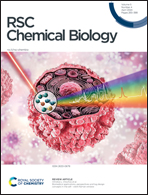Development of PCR primers enabling the design of flexible sticky ends for efficient concatenation of long DNA fragments†
Abstract
We developed chemically modified PCR primers that allow the design of flexible sticky ends by introducing a photo-cleavable group at the phosphate moiety. Nucleic acid derivatives containing o-nitrobenzyl photo-cleavable groups with a tert-butyl group at the benzyl position were stable during strong base treatment for oligonucleotide synthesis and thermal cycling in PCR reactions. PCR using primers incorporating these nucleic acid derivatives confirmed that chain extension reactions completely stopped at position 1 before and after the site of the photo-cleavable group was introduced. DNA fragments of 2 and 3 kbp, with sticky ends of 50 bases, were successfully concatenated with a high yield of 77%. A plasmid was constructed using this method. Finally, we applied this approach to construct a 48.5 kbp lambda phage DNA, which is difficult to achieve using restriction enzyme-based methods. After 7 days, we were able to confirm the generation of DNA of the desired length. Although the efficiency is yet to be improved, the chemically modified PCR primer offers potential to complement enzymatic methods and serve as a DNA concatenation technique.



 Please wait while we load your content...
Please wait while we load your content...